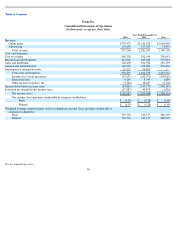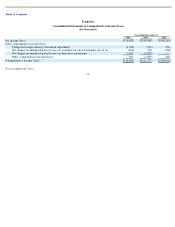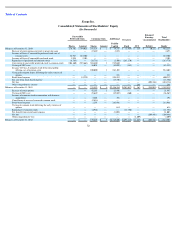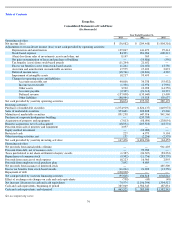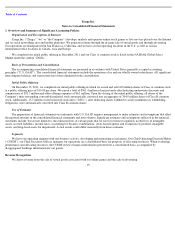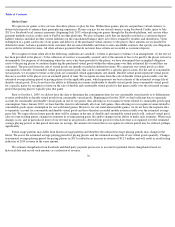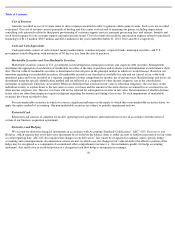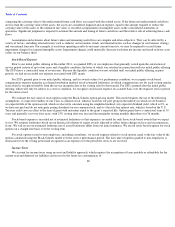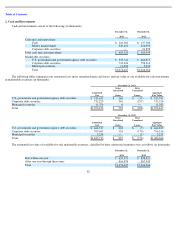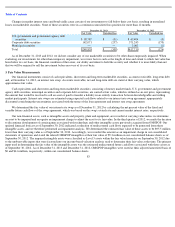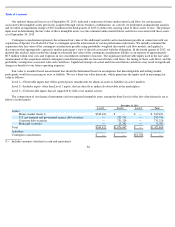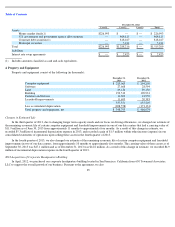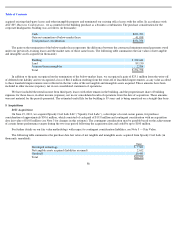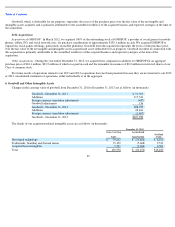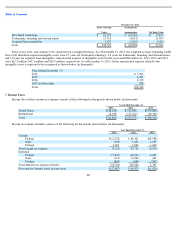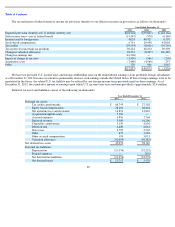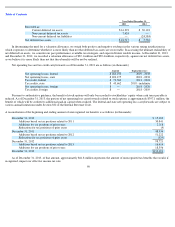Zynga 2013 Annual Report Download - page 84
Download and view the complete annual report
Please find page 84 of the 2013 Zynga annual report below. You can navigate through the pages in the report by either clicking on the pages listed below, or by using the keyword search tool below to find specific information within the annual report.
Table of Contents
comparing the carrying value to the undiscounted future cash flows associated with the related assets. If the future net undiscounted cash flows
are less than the carrying value of the assets, the assets are considered impaired and an expense, equal to the amount required to reduce the
carrying value of the assets to the estimated fair value, is recorded as impairment of intangible assets in the consolidated statements of
operations. Significant judgment is required to estimate the amount and timing of future cash flows and the relative risk of achieving those cash
flows.
Assumptions and estimates about future values and remaining useful lives are complex and often subjective. They can be affected by a
variety of factors, including external factors such as industry and economic trends, and internal factors such as changes in our business strategy
and our internal forecasts. For example, if our future operating results do not meet current forecasts, we may be required to record future
impairment charges for acquired intangible assets. Impairment charges could materially decrease our future net income and result in lower asset
values on our balance sheet.
Stock-Based Expense
Prior to our initial public offering in December 2011, we granted ZSUs to our employees that generally vested upon the satisfaction of
service period criteria of up to four years and a liquidity condition, the latter of which was satisfied in connection with our initial public offering.
The ZSUs have a contractual term of seven years. Because the liquidity condition was not satisfied until our initial public offering, in prior
periods, we had not recorded any expense associated with ZSU grants.
For ZSUs granted prior to our initial public offering, and for awards subject to a performance condition, we recognize stock-based
compensation expense using the accelerated attribution method, net of estimated forfeitures, in which compensation cost for each vesting tranche
in an award is recognized ratably from the service inception date to the vesting date for that tranche. For ZSUs granted after the initial public
offering, which will only be subject to a service condition, we recognize stock-based expense on a ratable basis over the requisite service period
for the entire award.
We estimate the fair value of stock options using the Black-Scholes option-pricing model. This model requires the use of the following
assumptions: (i) expected volatility of our Class A common stock, which is based on our peer group in the industry in which we do business;
(ii) expected life of the option award, which we elected to calculate using the simplified method; (iii) expected dividend yield, which is 0%, as
we have not paid and do not anticipate paying dividends on our common stock; and (iv) the risk-free interest rate, which is based on the U.S.
Treasury yield curve in effect at the time of grant with maturities equal to the grant’s expected life. Option grants have a contractual term of 10
years and generally vest over four years, with 25% vesting after one year and the remainder vesting monthly thereafter over 36 months.
Stock-based expense is recorded net of estimated forfeitures so that expense is recorded for only those stock-based awards that we expect
to vest. We estimate forfeitures based on our historical forfeiture of equity awards adjusted to reflect future changes in facts and circumstances,
if any. We will revise our estimated forfeiture rate if actual forfeitures differ from our initial estimates. We record stock-based expense for stock
options on a straight-line basis over the vesting term.
For stock options issued to non-employees, including consultants, we record expense related to stock options equal to the fair value of the
options calculated using the Black-Scholes model over the service performance period. The fair value of options granted to non-employees is
remeasured over the vesting period and recognized as an expense over the period the services are received.
Income Taxes
We account for income taxes using an asset and liability approach, which requires the recognition of taxes payable or refundable for the
current year and deferred tax liabilities and assets for the future tax consequences of
80


